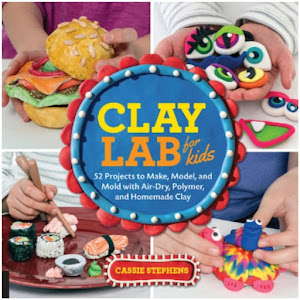 |
| Woven pouches created by fourth grade artists. You can see more of their masterpieces at our school-wide art show here and here. |
Since I shared with you photos from our art show, I've had several questions about the woven pouches that were featured. Because this project is so easy and fun, I thought I'd share it now that the kids are out of school and getting a little...well...restless. It's the perfect summer what-can-we-do-now-? craft.
In the art room, this project has become a rite of passage for my fourth grade students but can easily be created by kids as young as second grade. Because this craft involves multiple steps, I've divided it up into four posts: Weaving Part 1: Getting Started; Part 2: Weaving the Flap; Part 3: Removing the Weaving and Finishing; Part 4: Weaving a Cord
Please, fellow art teachers and parents, leave comments below on how you teach this lesson differently. And, of course, questions if you got 'em. Have fun!
Supplies:
- Scissors
- Tape
- a loom. I purchase ours through Sax but you can create your own with thick cardboard.
- Thin cotton string. This was bought for a couple bucks at Walmart but in a pinch, you could use yarn.
- Big-eyed needles. Again, Walmart would carry these in their craft department.
Preparing your loom:
These looms that I purchase through Sax have notches in them that are too far apart. When you weave with them like this, it creates a pouch that is a little too loosely woven, in my opinion. So I have the kids cut the part that sticks up (we call them "teeth") in half. It's a struggle because the cardboard is thick and there is some moaning and groaning but they can do it.
If you are creating your own loom from cardboard, you will want to space your notches about 1/4" apart. I'm not really into exact measurements, so I say just eyeball it. However, make sure that you have the same number of notches on the top as the bottom.
Warping your loom:
Warping your loom is the process in which you are putting the string on your loom that you will weave over and under. To do this, start at one corner of your loom and tape your warping string into place. I have the kids put the tape at the bottom of the notches. This will prevent the kids from accidentally weaving over or under this small string.
Now begin wrapping the warp string all the way around the loom. For example, from the taped end, go down to the bottom cut notch, wrap string around the back and up to the top notch and then go to the bottom again. You should have strings on both sides of your loom, making certain not to skip any of the pre-cut or notches-you-cut.
While you are warping, keep the string attached to the cone. I do not allow the kids to cut the string from the cone unless I have checked their loom. If they have skipped a notch, this allows them to go back and fix it without wasting any warping string.
Once you've checked the loom and are certain no notches were skipped, cut the string and tape it down. Again, tape as close to the notches as possible. Use your creepy bending finger (shown above) to scoot those other warp stings over to tape the string underneath.
Weaving:
The process of weaving is that of going over and under the warp strings in an A-B pattern. The string you weave with is called the weft. No long needle like this one? Tape your string to the end of a pencil or skewer stick.
Pull yarn through until you have left behind a 1" tail. Turn the loom over and weave over and under on the back. Once finished with that side, turn loom over to the original side.
Now, this time, weave the opposite of the previous string. For example, in the photo above, I wove over and under because the string underneath was under and over.
You know you are weaving correctly when you see something like this. Looks a little like the netting of a tennis racket.
But it's too loose. Do you see all of those white warp strings through your weaving? Well, you don't want to. Use a fork to pack down your weaving until those warp strings disappear and all you see are the weft strings.
Adding a new weft:
Okay, this one is debatable. Technically, you are not to tie two stings together but overlap the strings to add another. Or something. But at this point, if I throw one more piece of info at the kids, they are likely to have an aneurysm. So, we simply double knot tie a new string to the old, snip the "tails" and keep on weaving.
Incorrect weaving:
How do you know if you are weaving incorrectly? Well, you'll see a lot of vertical warp strings, like you see in the yellow portion of my weaving above. This happens when you are not weaving the opposite of the previous string, but weaving the same over and over again. If you see this, you have to take it out and redo.
Weaving away...
I tell the kids that their weaving must be somewhere in between 4-7" tall. This allows room at the top of the loom for weaving the flap and tying off the weaving. This should keep those kiddos all tied up (heehee, tempting, right?) until next week. I plan to take mine on an upcoming trip to keep me occupied.
Remember, you are weaving on both sides of the loom, front and back. Ya hear?
Remember, you are weaving on both sides of the loom, front and back. Ya hear?
So stay tuned!
Next week, we'll learn how to weave that flap. Again, feel free to leave any questions or comments and happy weaving!



































I'm going to try this myself! Thank you for posting. :)
ReplyDeleteI like the finished shape and size of your pieces. I do something similar w/my third graders without the cord/strap but my kids could easily do that with our kumihimo braids we do every year (4th grade). I use cereal boxes for my looms (free) and nylon cord (similar to floss or fishing line, but scavenged for free). To get the cutting of 'tabs' exact, I made a template that is glued to the end of the loom and the students use that as a cutting guide. I have the kids warp the loom a little differently than you so there is no need for tying off the ends afterwards - just loops that hold everything in place - and the flap is part of the piece! I would recommend that the start and end of every piece/row is placed in the center of the loom - that way the finished piece is stronger and there's no need for knots. You can see my woven pouch examples on my blog handsheadnheart@blogspot.org - I look forward to seeing the other techniques you used in finishing!
ReplyDeleteI absolutely, positively can not believe it took me so long to discover your blog! I stumbled across it this morning and was tickled to find this amazing woven bag tutorial. I would love doing this with my fearless group of 6th graders next year. I'll be giving it a try today with my craft buddy while we watch Wimbledon! Thanks so much for posting in such detail. I'll def be adding you to my blog roll! Best, Sunnylee
ReplyDeleteThese pouches are amazing! I weave with the 4th graders every year.....but we have never tried weaving on the front and back work strings. I am wondering how long this will take a 10 year old to complete....
ReplyDeleteHere's how I do this project...http://www.youtube.com/watch?v=xCRWn4P50fs&list=UUXntYqjvXTCVkkWBC2ad7uw&index=19&feature=plcp
ReplyDeleteI do a similar pouch but I do have them overlap threads, and yes they do freak a little! To help them understand I have two kids act as runners in a baton relay race. I tell students that the runners are like the two threads, one finishing their part and one beginning. When the old runner (new thread) is finished, the new runner (thread) runs with the old runner (old thread) for a few steps in the same direction, as they grab the baton. [There's a Jacob Lawrence print of a baton race that I show as well.] After a few steps together, the new runner(thread)runs alone. I use my Elmo-document camera (Every Art teacher needs one!!!), to show students how their weft threads should run in the same direction (over/over, under/under, over/over...) for about three to four warp threads, until the new weft thread is past the old one. Then when the new thread is running alone the pattern is opposite (over/under, under/over, over/under, and so forth.) I also put a red marker line above a blue line on the board to show the same thing. From multiple approaches like these, they seem to get it, though I usually must review a bit each week when they are first starting.
ReplyDeleteGo ahead and tie a knot. Once the pouch is off the loom, turn it inside out, and all the little tie ends are on the inside.
ReplyDeleteHow long would you guess that it would take 20 4th graders to complete a woven piece?
ReplyDeleteHi Heather -- Well...I have my fourth graders for 30 minutes, twice a week. It takes about a month for us to complete this project...shorter amount of time if you let them take them home and work on them. That's for the pouch alone. For the woven handle, it takes a pinch longer. You could introduce it before a long break and hope that they finish it and return it after a break...given they don't leave it at grandma's house ;) Hope that helps! Cassie
DeleteHow do I find the rest of the instructions please?
ReplyDeleteHi! At the top of this post I have links to the rest of the directions. Thanks for reading and have fun!
DeleteThanks for such a great tutorial. I am putting weaving off because I am really intimidated by the process. This gives me a bit of confidence.
ReplyDeleteYay! Try it out and if you have any questions, please feel free to ask :)
DeleteGoing to do this next year with the 5th graders! I got my cardboard looms in and made a pouch for myself last night just to try it out. Thank you for such a detailed post!
ReplyDeleteFound a new source for the chipboard looms: http://www.ebay.com/itm/Jack-Richeson-Chipboard-Student-Weaving-Loom-3-1-4-X-13-Inches-Pack-of-12-/181447565150?pt=US_Yarn&hash=item2a3f1e1f5e
ReplyDeleteHello! We love making these pouches with 4th grade. It's the hit of the year. BUT..I can't find your post on how you sew on the buttons. Can you please direct me?
ReplyDeleteI am having a problem when I flip the loom. It is really confusing the students and they mess up their over under alternating weaving. Any suggestions?
ReplyDeleteDo you purchase new looms for each class?
ReplyDeleteYes, I do because they take a beating. But I also recycle the covers from used notebooks and cut them into new looms.
DeleteI had my students use two craft sticks - one front and one back, connected with small pieces of masking tape at the end to make a double-sided beater bar.
ReplyDeleteI made these with 8th grade last year and I'm actually about to start these with my intro to art high school students. Everybody needs a handmade cell phone pouch right? :) Thanks for the great tutorial!
ReplyDeletewow you have got a great craft skills. I must say there is a lot which i can learn from your blog.
ReplyDeletemeet and greet parking Heathrow
What size are your looms?
ReplyDeleteI love this project! My second year doing it with 5th grade!
ReplyDeleteI don't use the pre-made looms, instead I cut 4x6 or 6x6 pieces of cardboard. Then I have the kids measure 1/4 inch intervals along top and bottom and snip them.
I love it this way for a few reasons:
1) The early finishers can grab any size cardboard laying around and make their own loom again.
2) my poor school has one less thing to spend budget money on!
3) Recycling!
4) the kids can make any size!!! (My kiddos all want to make pouches specific for their phone/pencils/random treasures)
5) it turns trash cardboard into usable art supply (and empowers kids to make these on their own without adult help!)
I don't do the top flap. I do "assess" them by making each child demonstrate how to tie a square knot.
Finally, I do a twisted strap that forces them to work together! It's a blast and I inevitably have children knocking on my door, asking for more yarn, on a daily basis. I love it!
Hi Cassie,
ReplyDeleteI start weaving a pouch recently, the problem is, sides of my pouch,is loose ( some of it)
Why is that so?
Have a lovely day
Pauline
Hi all! I want to try this with 2 grade leavels so about 200 kids. How much yarn do you order per class of say 30? It's my first time and wanted to be sure I order enough.
ReplyDeleteThanks!
Jackie Gray
The craftsmanship of the bloggers is great. I once tried to weave a handbag, but unfortunately did not succeed.
ReplyDeleteDo you think 3rd graders could handle this if I break it down, step by step as you have?
ReplyDeleteI, too, noticed the notches are too far apart so I like the idea of cutting them in half. Also, we will try doubling the thread in each notch to give more warp for my high school shelter kids to weave. We will also try making stuffed weaving dolls and add limbs and button heads. Beads can also be incorporated in the weaving and limbs.
ReplyDelete